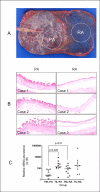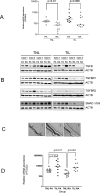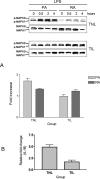Region-specific gene expression profiling: novel evidence for biological heterogeneity of the human amnion
- PMID: 18685129
- PMCID: PMC2714995
- DOI: 10.1095/biolreprod.108.069260
Region-specific gene expression profiling: novel evidence for biological heterogeneity of the human amnion
Abstract
The amnion plays an important role during pregnancy and parturition. Though referred to as a single structure, this fetal tissue is regionally divided into placental amnion, reflected amnion, and umbilical amnion. Histological differences between placental amnion and reflected amnion led us to hypothesize that the amnion is biologically heterogeneous. The gene expression profiles of placental amnion and reflected amnion were compared in patients at term with no labor (TNL; n = 10) and in labor (TIL; n = 10). Real-time quantitative RT-PCR revealed a higher expression of IL1B mRNA in reflected amnion than in placental amnion in TNL cases but not in TIL cases. Extended screening using microarrays showed differential expression of 17 genes in labor, regardless of the region. Interestingly, 839 genes were differentially expressed between placental amnion and reflected amnion. Pathway analysis identified 19 signaling pathways, such as mitogen-activated protein kinase and transforming growth factor beta pathways, associated with region. Lipopolysaccharide (LPS) treatment of the amnion explants showed more robust activation of mitogen-activated protein kinase 3/1 (extracellular signal-regulated kinase 1/2) in placental amnion of TNL but not in TIL cases. Placental amnion from TNL and TIL cases showed a significant difference in the amplitude of IL1B mRNA induction by LPS. We report that the anatomical region has a substantial impact on the transcriptional program and the biological properties of the amnion. Labor-associated switching to a proinflammatory signature is a feature particular to placental amnion. The novel observations herein strongly suggest that the seemingly homogeneous amnion is biologically heterogeneous and compartmentalized, with implications for the physiology of pregnancy and parturition.
Figures




References
-
- Millar LK, Stollberg J, Debuque L, Bryant-Greenwood G.Fetal membrane distention: determination of the intrauterine surface area and distention of the fetal membranes preterm and at term. Am J Obstet Gynecol 2000; 182: 128–134.. - PubMed
-
- Benirschke K, Kaufmann P.Anatomy and pathology of the placental membranes. Pathology of the Human Placenta, 4th ed New York:Springer;2000: 281–334..
-
- Arikat S, Novince RW, Mercer BM, Kumar D, Fox JM, Mansour JM, Moore JJ.Separation of amnion from choriodecidua is an integral event to the rupture of normal term fetal membranes and constitutes a significant component of the work required. Am J Obstet Gynecol 2006; 194: 211–217.. - PubMed
-
- Oyen ML, Calvin SE, Landers DV.Premature rupture of the fetal membranes: is the amnion the major determinant? Am J Obstet Gynecol 2006; 195: 510–515.. - PubMed
-
- Parry S, Strauss JF., IIIPremature rupture of the fetal membranes. N Engl J Med 1998; 338: 663–670.. - PubMed
Publication types
MeSH terms
Substances
Grants and funding
LinkOut - more resources
Full Text Sources

